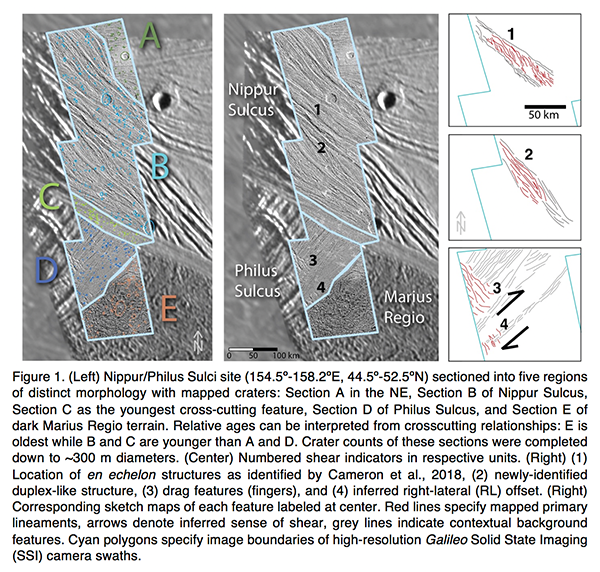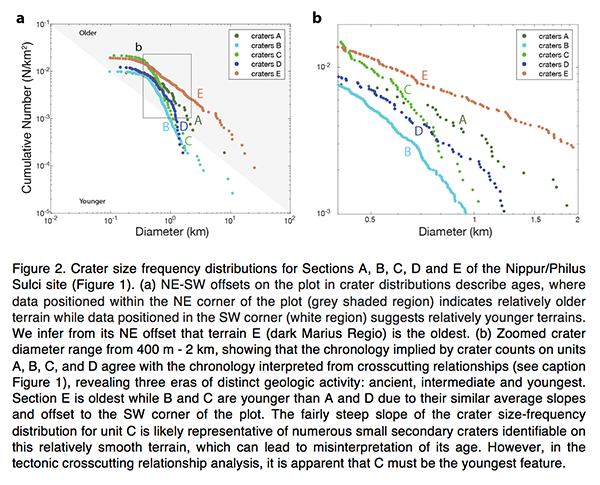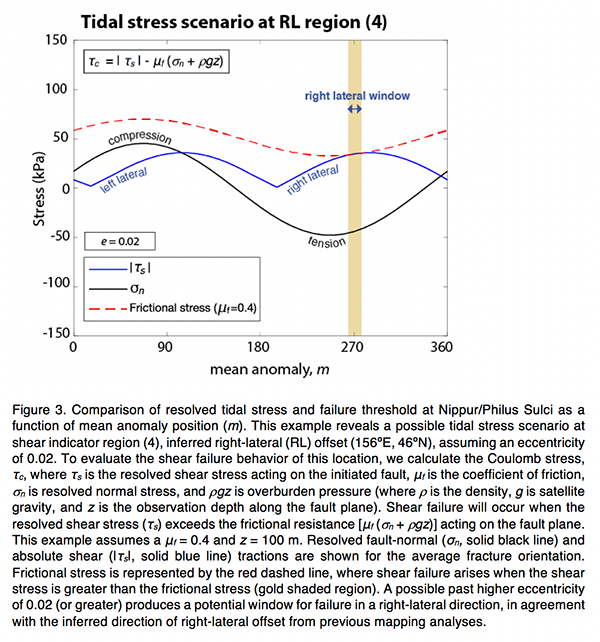Uncovering the tectonic past of Ganymede through crater size frequency distribution and tidal Coulomb failure modeling at Nippur/Philus Sulci
- 1Department of Earth Sciences, University of Hawai‘i at Mānoa, Honolulu, USA
- 2Hawai‘i Institute of Geophysics and Planetology, University of Hawai‘i, Honolulu, USA
- 3Jet Propulsion Laboratory, California Institute of Technology, Pasadena, USA
Voyager and Galileo observations of Jupiter's largest moon Ganymede revealed numerous fractures and evidence of strike-slip faulting. The formation of these features has been studied by considering gravitational tidal forces and extensional tectonism, but remains enigmatic. In this study, we continue to advance the assessment of Ganymede’s geologic history by examining the high-resolution Galileo Solid State Imaging (SSI) camera images (∼100m/pixel) available for the area of Nippur/Philus Sulci (Figure 1). Here, various geologic units align on a single line of longitude, providing an excellent sampling region of Ganymede’s deformed surface and eliminating the need to correct for possible leading/trailing hemisphere disparities in the cratering record (Figure 2). First, we produced new crater counts and size frequency distributions to define the relative ages of terrains and their individual geologic units. The chronology of tectonic activity implied by mapped crosscutting relationships is consistent with our findings from analyses of crater densities for each unit, revealing three eras of distinct geologic activity: ancient, intermediate and youngest. Moreover, crosscutting bands of light terrain throughout the surface of Ganymede (and at the Nippur/Philus Sulci site) show varying degrees of tectonic distortion related to these eras of activity, ranging from smooth and less distorted bands to highly grooved and deformed terrain with indicators of shear deformation and strike-slip offsets. To further constrain the timing of geologic activity, we conducted a tidal stress analysis to better understand the formation of shear deformation inferred within the region. Previous studies suggest that tidal stresses resulting from a high eccentricity can generate stress fields capable of driving shear failure and promoting tectonism. At present, Ganymede’s diurnal tidal stresses are not large enough to initiate shear failure. However, the Galilean satellites could have been captured for a period of 10 Ma to 1 Ga years in two Laplace-like resonances previous to the current state and eccentricity. In this past phase, the eccentricity could have been as high as e = ∼0.07, driving internal activity as well as subsequent resurfacing. Using examples of shear deformation indicators found in the Nippur/Philus Sulci area, we examined higher values of past eccentricity to evaluate the promotion of shear failure using the SatStress tidal stress model and Coulomb failure theory, where tractions are resolved onto shallow fault planes (100 m depth) with azimuthal orientations consistent with mapped observations (Figure 3). We find that candidate past eccentricities > 0.02 provide optimal conditions for shear failure throughout the Nippur/Philus Sulci region in its intermediate phase of geologic activity, implied by the positioning of shear indicators within intermediate units as identified by the cratering analysis. Moreover, a past higher eccentricity could have produced a stress field conducive to shear failure of the icy upper crust and possibly promoted the formation of the inferred shear features of Nippur/Philus Sulci and beyond. Future high-resolution images, provided by NASA’s Juno mission, as well as future observations by ESA’s Jupiter Icy Moons Explorer (JUICE) mission and NASA’s Europa Clipper mission, may further aid in our understanding of synergies within Ganymede’s cratering record and tectonic history, especially in the far-field regions surrounding this study, for which only lower resolution Voyager data is currently available.



How to cite: Burkhard, L., Costello, E., Smith-Konter, B., and Cameron, M.: Uncovering the tectonic past of Ganymede through crater size frequency distribution and tidal Coulomb failure modeling at Nippur/Philus Sulci, Europlanet Science Congress 2022, Granada, Spain, 18–23 Sep 2022, EPSC2022-305, https://doi.org/10.5194/epsc2022-305, 2022.

